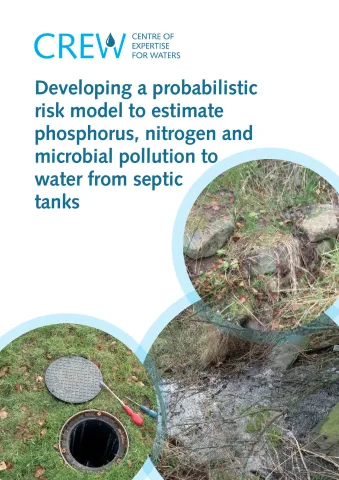Septic tank systems (STS) are private sewage treatment facilities which typically serve the population not connected to main sewer networks. There is substantial uncertainty about the impact of septic tanks on water quality, primarily because of a lack of information about the location, number and condition, and inadequate monitoring of the effects of septic tank discharges to surface water and groundwater.
Under the requirements of the Water Framework Directive, there is a need for SEPA to identify pressures contributing to water quality downgrades and to put in place appropriate and feasible measures to return waters to good status. SEPA currently use the SAGIS model to identify major pollutants including phosphorus (P) loads and concentrations at the waterbody scale. However, assumptions regarding parameterisation and uncertainty of SAGIS model outputs, particularly in rural areas, make it difficult to quantify the sources of P pollution from septic tanks. A new approach to modelling the contribution of STS P loading is therefore required to inform mitigation strategies, while accounting for uncertainties.
The aim of this project was to review the literature and develop a new probabilistic modelling approach, based on Bayesian Belief Networks (BBN), to improve understanding of soluble reactive phosphorus (SRP) losses to surface water from STS. This was initially undertaken for seven pilot catchments and then at a national scale. The model included a range of risk factors related to SRP losses from STS, resulting in simulated SRP losses that were comparable with previously available estimates. The project also considered what factors would need to be applied for modelling nitrogen (N) and microbial (FIOs) pollution risk from STS.
Key findings indicate that: (1) Poor performance of a large proportion of STS and hence the risk of SRP leaching to water bodies are related to the lack of proper soakaway system, poor soil quality, undersized STS, and lack of maintenance. Hence the literature review suggested multiple risk factors contributing to STS pollution risk to watercourses need to be considered when simulating SRP losses; (2) Model sensitivity analysis identified STS effluent concentration, STS density, and connectedness as the most important risk factors; (3) Upgrading of STS treatment to secondary or tertiary level, improving STS maintenance and/or disconnecting STS direct discharges to watercourses would be most effective in mitigating SRP losses at catchment scale; (4) The model could be adapted relatively easily to simulate microbial (faecal indicator organisms) and nitrogen losses from STS to surface water. A detailed catchment-based survey of STS condition would be beneficial to validate and improve BBN model parameterisation.
| Attachment | Size |
|---|---|
| Main Report Septic Tank Modelling | 6.06 MB |
